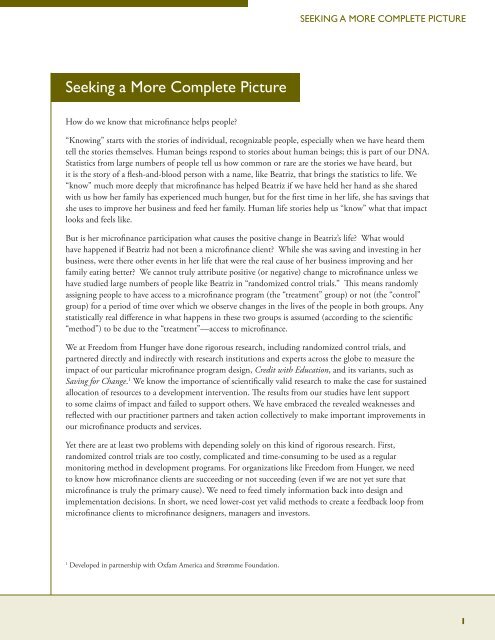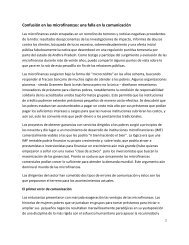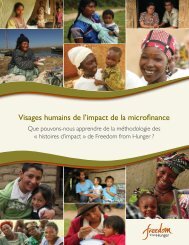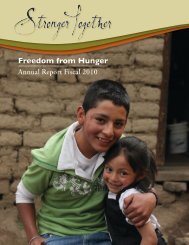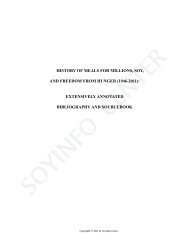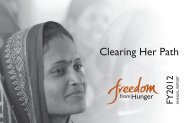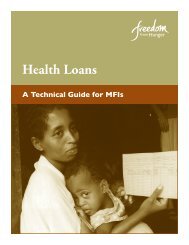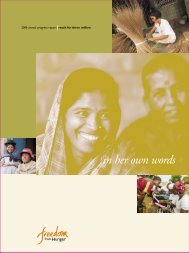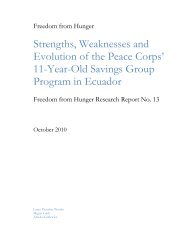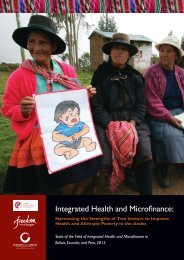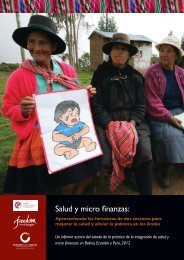English - Freedom from Hunger
English - Freedom from Hunger
English - Freedom from Hunger
You also want an ePaper? Increase the reach of your titles
YUMPU automatically turns print PDFs into web optimized ePapers that Google loves.
seeking a More Complete Picture<br />
How do we know that microfinance helps people?<br />
seekIng a MoRe CoMPleTe PICTuRe<br />
“Knowing” starts with the stories of individual, recognizable people, especially when we have heard them<br />
tell the stories themselves. Human beings respond to stories about human beings; this is part of our DNA.<br />
Statistics <strong>from</strong> large numbers of people tell us how common or rare are the stories we have heard, but<br />
it is the story of a flesh-and-blood person with a name, like Beatriz, that brings the statistics to life. We<br />
“know” much more deeply that microfinance has helped Beatriz if we have held her hand as she shared<br />
with us how her family has experienced much hunger, but for the first time in her life, she has savings that<br />
she uses to improve her business and feed her family. Human life stories help us “know” what that impact<br />
looks and feels like.<br />
But is her microfinance participation what causes the positive change in Beatriz’s life? What would<br />
have happened if Beatriz had not been a microfinance client? While she was saving and investing in her<br />
business, were there other events in her life that were the real cause of her business improving and her<br />
family eating better? We cannot truly attribute positive (or negative) change to microfinance unless we<br />
have studied large numbers of people like Beatriz in “randomized control trials.” This means randomly<br />
assigning people to have access to a microfinance program (the “treatment” group) or not (the “control”<br />
group) for a period of time over which we observe changes in the lives of the people in both groups. Any<br />
statistically real difference in what happens in these two groups is assumed (according to the scientific<br />
“method”) to be due to the “treatment”—access to microfinance.<br />
We at <strong>Freedom</strong> <strong>from</strong> <strong>Hunger</strong> have done rigorous research, including randomized control trials, and<br />
partnered directly and indirectly with research institutions and experts across the globe to measure the<br />
impact of our particular microfinance program design, Credit with Education, and its variants, such as<br />
Saving for Change. 1 We know the importance of scientifically valid research to make the case for sustained<br />
allocation of resources to a development intervention. The results <strong>from</strong> our studies have lent support<br />
to some claims of impact and failed to support others. We have embraced the revealed weaknesses and<br />
reflected with our practitioner partners and taken action collectively to make important improvements in<br />
our microfinance products and services.<br />
Yet there are at least two problems with depending solely on this kind of rigorous research. First,<br />
randomized control trials are too costly, complicated and time-consuming to be used as a regular<br />
monitoring method in development programs. For organizations like <strong>Freedom</strong> <strong>from</strong> <strong>Hunger</strong>, we need<br />
to know how microfinance clients are succeeding or not succeeding (even if we are not yet sure that<br />
microfinance is truly the primary cause). We need to feed timely information back into design and<br />
implementation decisions. In short, we need lower-cost yet valid methods to create a feedback loop <strong>from</strong><br />
microfinance clients to microfinance designers, managers and investors.<br />
1 Developed in partnership with Oxfam America and StrØmme Foundation.<br />
1


